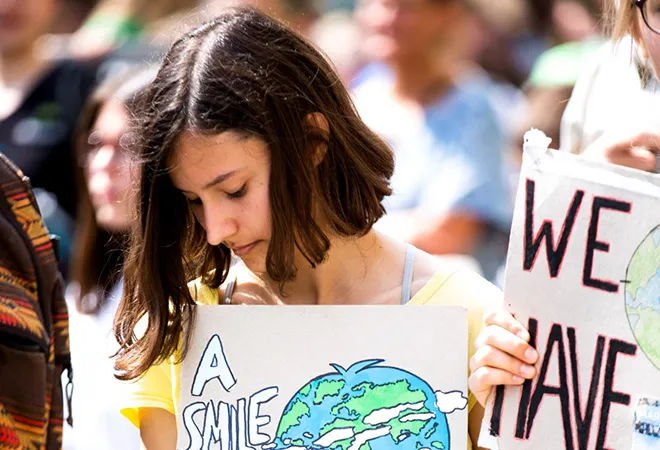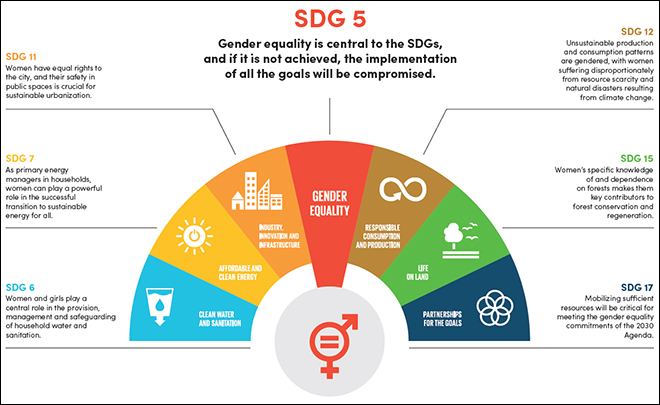
The 17 Sustainable Development Goals (SDGs) were envisaged by the UN to provide a platform for inclusive, universal, locally-focused, technologically-driven and integrated development. One of the main cornerstones of the SDGs is that ‘no one is left behind’ and all stakeholders are engaged. However, despite having a dedicated goal towards achieving Gender Equality (SDG 5), disadvantageous positions for women and girls get flagged in each realm of the sustainability objectives. This is of utmost importance in the light of the COVID-19 pandemic — which has lopsided effects across genders in most countries, including India. The following SDGs table depicts the gender issues as an equity concern across different domains.
Table: Gendered perspective on the SDGs
| SDGs |
Relevant Estimates |
| SDG 1: No Poverty |
Women and girls around the world are 4 percent more likely than men and boys to live in extreme poverty and the risk rises to 25 percent for women aged between 25 to 34. |
| SDG 2: Zero Hunger |
Globally, women have a 10 percent higher risk of experiencing food insecurity than men. |
| SDG 3: Good Health and Well-Being |
Nearly 300,000 women die from complications related to pregnancy and childbirth in a year. |
| SDG 4: Quality Education |
Nearly 15 million girls relative to 10 million boys of primary school age are out of school. |
| SDG 5: Gender Equality |
Worldwide only 1 in 4 parliamentary seats are held by women. |
| SDG 6: Clean Water and Sanitation |
Women and girls spend nearly a total of 200 million hours every day collecting water. |
| SDG 7: Affordable and Clean Energy |
Globally, nearly 3 billion people lack access to clean fuel. Women and children are adversely impacted since they are main procurers and users of household energy. |
| SDG 8: Decent Work and Economic Growth |
Labour force participation rate of women aged 25 to 54 is 55 percent while it is 94 percent for men in the same age group. |
| SDG 9: Industry, Innovation and Infrastructure |
On average, only 28.8 percent of the world’s researchers are women. |
| SDG 10: Reduced Inequalities |
Assessment of migration policies indicated that 71 percent countries impose restrictions on spouses and partners (mostly women) joining migrants. |
| SDG 11: Sustainable Cities and Communities |
Women are overrepresented in slums in 70 percent of countries where data is available. |
| SDG 12: Responsible Consumption and Production; SDG 13: Climate Action; SDG 14: Life Below Water; SDG 15: Life on Land |
38.7 percent of employed women are in agriculture, forestry and fisheries but only 13.8 percent of landholders are women. |
| SDG 16: Peace, Justice and Strong Institutions |
3 in 4 human trafficking victims are women and girls. |
| SDG 17: Partnerships for Goals |
Out of the US$ 117 billion in Overseas Development Assistance (ODA) commitments received by developing nations in the previous years, only 38 percent targeted gender equality or women’s equality as a primary or secondary objective. |
Source: Authors’ own, complied from ‘The Gender Snapshot 2019’ by UN Women.
In the Indian context, although India has an overall improved SDG score of 61.92 (out of 100) and ranks 117 out of 193 UN member states in terms of SDGs achievement in the Sustainable Development Report 2020 — ‘major challenges remain’ for the country in achieving SDG 5.
Women form nearly 70 percent of the workers in the global health and social care sector.
Previous disease outbreaks had gendered impacts as well — as was seen in the 2014 Ebola crisis in West Africa and the 2015-16 outbreak of Zika virus in Brazil. The recent pandemic has also contributed to reinforcing the gender inequalities in various spheres. Women form nearly 70 percent of the workers in the global health and social care sector. They are thus on the frontlines to contain the pandemic and therefore at high risk of contracting the disease. In India, estimates show that qualified female healthcare workers account for almost half of country’s health force and make up a staggering 88.9 percent of trained nurses and midwives. As health care services are diverted towards COVID-19, women’s reproductive health is also likely to be impacted due to inadequate access to contraception, maternal healthcare and childcare services.
The lockdown imposed by various countries to tackle the pandemic has led to several harmful social and economic effects as well. Being locked down at homes has led to increased cases of domestic abuse being recorded across the world. Women are disproportionately represented in precarious informal sector — in South Asia nearly 95 percent of employed women are in the informal category and for Sub-Saharan Africa it is 89 percent. The lack of job security and social protection in this sector, along with social distancing diktats are likely to have a negative impact on the income and earning potential of women.
The recent shift towards online education also has a gendered impact as there exists a substantial digital divide between women and men. Globally, an estimated 327 million fewer women have access to a smartphone as compared to men. Also when multiple family members need to share technological resources such as the Internet, inherent gender inequality may lead to women and girls being given less access.
The recent shift towards online education also has a gendered impact as there exists a substantial digital divide between women and men.
During the COVID-19 crisis, in many communities in India, issues surrounding access to water have directly impacted women who spend hours queuing up around community water sources. This impedes practicing social distancing norms with the added health hazard from heat waves being observed around the country. Domestic responsibilities borne by women have also increased multifold coupled with lower access to nutritional food.
The COVID-19 crisis offers a valuable opportunity to reassess the SDGs framework which largely neglects the crucial gendered implications of realising the goals. At a time when women and girls are often at the losing end of development policies, the other gender and the Lesbian Gay Bisexual Transgender Intersex and Queer (LGBTIQ) communities are affected in an even worse manner. The pandemic has caused the Indian LGBTIQ+ community to face issues like discrimination, loss of employment, isolation and delayed access to healthcare. Taking these dimensions into account becomes vital due to the interconnectedness between the SDGs. The following figure outlines the SDG 5 inter-linkages with the other goals.
Figure: SDG 5 Inter-linkages
 Source: UN Women
Source: UN Women
In conclusion, it must be noted that neither can gender issues be divorced from the individual SDGs nor make desired progress through a single SDG alone. What we need is a framework that creates a more gender holistic future throughout the entire sustainable development paradigm.
The views expressed above belong to the author(s). ORF research and analyses now available on Telegram! Click here to access our curated content — blogs, longforms and interviews.




 Source:
Source:  PREV
PREV


